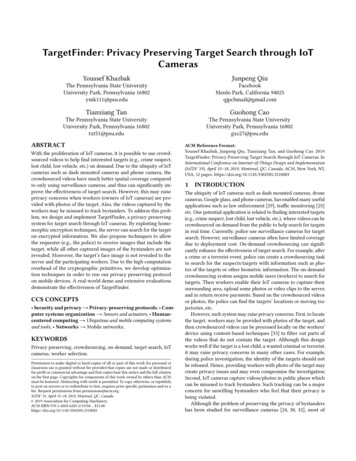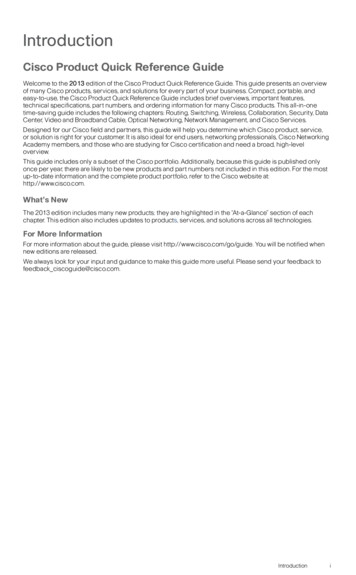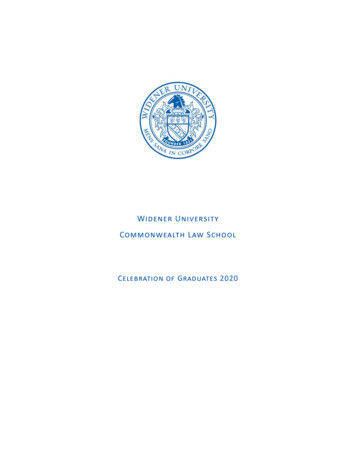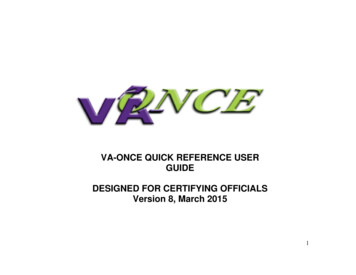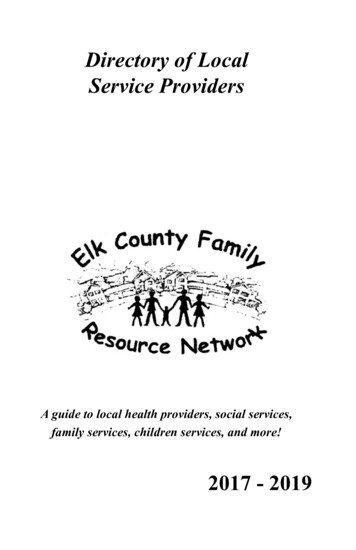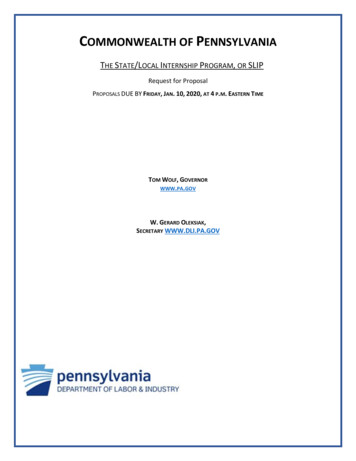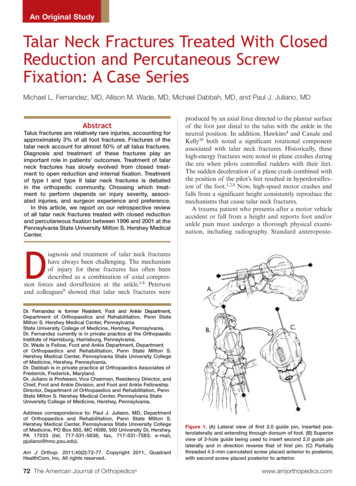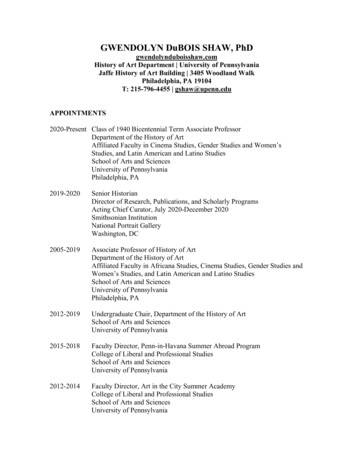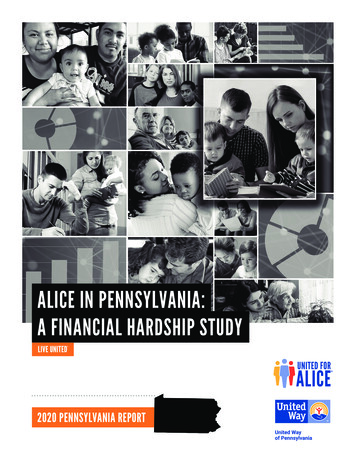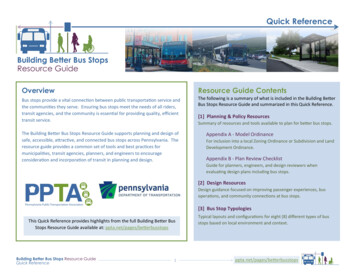
Transcription
Quick ReferenceOverviewResource Guide ContentsBus stops provide a vital connection between public transportation service andthe communities they serve. Ensuring bus stops meet the needs of all riders,transit agencies, and the community is essential for providing quality, efficienttransit service.The following is a summary of what is included in the Building BetterBus Stops Resource Guide and summarized in this Quick Reference.The Building Better Bus Stops Resource Guide supports planning and design ofsafe, accessible, attractive, and connected bus stops across Pennsylvania. Theresource guide provides a common set of tools and best practices formunicipalities, transit agencies, planners, and engineers to encourageconsideration and incorporation of transit in planning and design.[1] Planning & Policy ResourcesSummary of resources and tools available to plan for better bus stops.Appendix A - Model OrdinanceFor inclusion into a local Zoning Ordinance or Subdivision and LandDevelopment Ordinance.Appendix B - Plan Review ChecklistGuide for planners, engineers, and design reviewers whenevaluating design plans including bus stops.[2] Design ResourcesDesign guidance focused on improving passenger experiences, busoperations, and community connections at bus stops.[3] Bus Stop TypologiesThis Quick Reference provides highlights from the full Building Better BusStops Resource Guide available at: ppta.net/pages/betterbusstopsBuilding Better Bus Stops Resource GuideQuick Reference1Typical layouts and configurations for eight (8) different types of busstops based on local environment and context.ppta.net/pages/betterbusstops
[1] Planning and Policy ResourcesPart 1—Planning and Policy Resources of the Building BetterBus Stops Resource Guide identifies tools to incorporate andconsider public transportation in land use plans and policies. Itprovides guidance about how to incorporate fixed route busservices and stops into comprehensive plans, land developmentordinances, and other transportation plans. It emphasizespartnerships in achieving effective transit planning. It alsointroduces Appendix A—Model Ordinance Language andAppendix B– Plan Review Checklist.Public Transportation BenefitsDelivers Economic OpportunityPublic Transportation and Land Use 10 billion/year statewide in economic activityPublic transportation is inherently linked to the people it transports andthe land uses those people frequent. Public transportation moves peoplebetween work, shopping, medical appointments, leisure activities, andhome.Safer than a car10x safer/mileSaves moneyHousehold savings of 10,000/year by living with one less carIn Pennsylvania, municipalities have the power to plan and regulate landuse. Public transportation agencies or authorities are responsible forplanning and operating transit services, including fixed route bus service.While roles and responsibilities are separated, land use and transit areclosely related. Land use development and design directly impact publictransportation services and ridership.Decreases gas consumption1 passenger mile 1/2 fuel consumption of private vehicleReduces air pollution1 passenger mile 95% less CO, 92% less VOCs, 50% less CO2 and NOCoordination between municipalities, transit agencies, property owners,developers, and residents can increase the use of public transit, offeringnumerous community benefits. Municipalities can encourage transitagencies to serve their citizens through transit-supportive land use anddevelopment decisions.Increases MobilityFor ALL ridersEncourages Healthier Habits2/3 of riders walk to bus stopsSources: American Public Transportation Association (APTA) and Pennsylvania PublicTransportation Association (PPTA)Building Better Bus Stops Resource GuideQuick Reference2ppta.net/pages/betterbusstops
[1] Planning and Policy ResourcesMunicipal Planning Tools Supporting Public TransportationPublic transportation is a vital component of the mobility network in manycommunities across Pennsylvania. Municipal planning should consider howpublic transportation interfaces with existing and future land uses to maximizebenefits for transit riders and thecommunity.Public transportation should beconsidered and incorporated into avariety of local government plans andstudies, including, but not limited to,the following typical municipalplanning documents: Comprehensive PlansOfficial Map and OrdinanceCapital Improvement PlansEconomic Development/Revitalization Plans Open Space/Recreation Plans Corridor/Special Area Plans Active Transportation PlansImage Credit: LANTA Transit Supportive Land Use forthe Lehigh Valley, September 2013Above: Sample corridor with fixed route bus transitservice shows how local land use regulationsimpact and support transit. The site layout, buildingorientation, driveway/parking configurations, andpedestrian infrastructure provide safe, convenientand attractive connections between the bus routeand destinations. This transit supportive designallows buses to operate on their desired routewithout deviating to serve specific locations.See Resource Guide Page 1-4Steps: Incorporating Public Transportationinto Municipal PlanningEvaluate Existing Conditions Existing Stop and Route LocationsKey DestinationsTransit Dependent PopulationsService FrequencyRidershipAccessBuilding Better Bus Stops Resource GuideQuick ReferenceIdentify Future Needs Future GrowthLand Use ChangesTransit Oriented DevelopmentDemographic TrendsLocal land useregulationsand designrequirementscan play a key role infacilitating efficient andhigh quality publictransportation.Develop Recommendations Coordinate with TransitService Providers Implement Transit-SupportiveLand Use and InfrastructureSee Resource Guide Page 1-63ppta.net/pages/betterbusstops
[1] Planning and Policy ResourcesBuilding PartnershipsTransit Supportive Partnerships help to proactively incorporate transit intomunicipal planning and design, strengthening and supporting transit as anaccessible and viable transportation option.Local Transit Agency CoordinationTransit agencies and authorities are responsible for planning andevaluating transit services within their service area. Service planning andlonger range transit planning processes are opportunities for communitiesto provide input regarding the local vision and needs for transit.Municipalities should coordinate with transit providers forService Planning, Transit Development Plans, and Land DevelopmentPlan Review.See Resource Guide Page 1-12Image Credit:LANTA TransitSupportive Land Usefor the Lehigh Valley,September 2013Best Practices: Transit Supportive Land Use and DesignThe Pennsylvania Municipalities Planning Code (MPC) enables municipalities to enact Zoning Ordinances andSubdivision and Land Development Ordinances (SALDOs) to protect public health, safety, and welfare andimplement the comprehensive plan. Municipalities can incorporate transit supportive design into ZoningOrdinances and SALDOs to accommodate and support public transportation.Land Use Encourage Mixed-Use Permit Higher Density Focus Development along ExistingAbove: Example showing transit supportive site plansfor industrial/office and commercial buildings.Sidewalks, crosswalks, and overall site design providesafe and convenient connections for transit riders.Strengthening PartnershipsParking Reduce Parking Minimums Price On-street Parking Appropriately Require Bicycle ParkingTransit RoutesPedestrian / Bicycle Connections and AmenitiesSite Design Reduce Barriers to Transit AccessRequire Pedestrian NetworksRelocate Parking and Car AccessAccommodate Transit VehiclesIncorporate Access Management Require SidewalksRequire Marked CrosswalksEncourage Landscaping/StreetscapingPromote On-road and Off-road Bicycle FacilitiesBus Stops SafeAccessibleAttractiveConvenientPennDOT Connects isfocused on promotingcollaboration with localgovernments, MPOs/RPOs,and transit agencies at thebeginning of a project;increasing efficiency andcost effectiveness.See Resource Guide Page 1-8Building Better Bus Stops Resource GuideQuick Reference4ppta.net/pages/betterbusstops
[1] Planning and Policy ResourcesImplementation ResourcesImplementing bus stop improvements isnot the sole responsibility of one entity.Rather, enhancements to the builtenvironment, including those that supportpublic transportation, are made over timethrough public and private investment inthe community. Part 1 of the BuildingBetter Bus Stops Resource Guide includesreference to resources focused onimplementation: Transportation Improvement ProjectsLand Development ProjectsPublic-Private PartnershipsFunding SourcesModel Ordinance LanguageAppendix A of Building Better Bus Stops Resource Guide includes model ordinance language to incorporatepolicies and design guidelines for new or improved bus stops into municipal zoning ordinances andSALDOs. The Model Ordinance Language contains: Definitions for common bus stop elementsBus stop location and designguidanceRequirements forcoordinating potential busstop locations with transitagencies based ondevelopment location/typeSpecific design guidelinesand ADA requirements forbus stop infrastructure: ADASee Resource Guide Appendix Aloading pads, bus shelters, benches, and other street furnitureAgreement or permit requirements for installation and maintenance of bus stop infrastructure.Plan Review ChecklistAppendix B of the Building Better Bus Stops Resource Guide includes a Plan Review Checklist for planners,engineers, and other design reviewers. It can be used to evaluate whether a land development plan orother transportation improvement plan includes appropriate bus stop infrastructure. Determination of abus stop location and bus stopdesign should be closelycoordinated with the transitagency and municipality. Thechecklist includes generalrequirements for:See Resource Guide Page 1-17 ADA Loading PadsBus Stop SignsBenchesBus SheltersSee Resource Guide Appendix BBuilding Better Bus Stops Resource GuideQuick Reference5ppta.net/pages/betterbusstops
[2] Design ResourcesPart 2—Design Resources of the Building Better Bus StopsResource Guide provides guidance related to the design of busstops. It covers fixed route bus stop placement, configuration, andkey elements, including ADA accessibility and pedestrian access. Italso provides guidance for the placement, design, and maintenanceof ADA loading pads, clear zones for waiting areas, and other busstop amenities. Shelters, benches, bicycle parking, lighting,landscaping, and other amenities can increase the comfort andconvenience of passengers and also help to make the bus stop moreattractive.Basic Bus Stop Design PrinciplesBus Stop DesignAccessible to everyone.Bus stops are gateways to public transportation services and a key elementof a multimodal transportation system. Bus stop design directly impactspublic transportation riders in terms of accessibility, safety, comfort, andconvenience. Additionally, the bus stop design impacts the quality,efficiency, and cost-effectiveness of public transportation operations. Eachbus stop is unique and the design must consider the site specific context,potential users, roadway and roadside features, and land use context.Safe, convenient, and comfortable location.Visible and easily identifiable.Bus stop designs should be developed through coordination with the publictransit agency, owner of the roadway, and the adjacent property owner, ifapplicable. Additionally, provisions and agreements for ongoingmaintenance should be identified prior to installation. Bus stops should bemore than a sign on a post; they are a community asset, focal point of thestreetscape, and a public gathering space.Good pedestrian access and connections.Well integrated with surroundings.Includes amenities to make the wait comfortable.Supports efficient and effective bus operations.Source: Adapted from Memphis Area Transit Authority (MATA) Bus Stop andAccessibility Guidelines, 2017Building Better Bus Stops Resource GuideQuick Reference6ppta.net/pages/betterbusstops6
[2] Design ResourcesSteps: Planning and Designing a Bus StopOutlined below are key steps for planning and designing new or improved bus stops. Coordinate with the transit agency regarding specific steps,policies, and practices.[1] Identify[2] EvaluateIdentify potential for a new or improved busstop during planning/design for projects withone of the following criteria:[3] DesignCoordinate with the transit agency andevaluate need, location, and feasibility of anew or improved bus stop. Transportation improvement projectnearby an existing or planned bus route Land development project nearby,particularly when it may generate transittrips Community request for bus stopenhancementsNo new or improved bus stopThe transit agency may determine that a bus stop isnot necessary or feasible based on current conditions,but could be needed in the future. Consider reservingright-of-way, providing easements, or installingpedestrian infrastructure to support a future stop. Coordinate with transit agency,municipality, roadway owner, andadjacent property owner, as needed Determine bus stop placement andconfiguration Determine bus stop elements andamenities Obtain necessary permits/approvals andexecute maintenance agreementsSee Resource Guide Page 2-1 and 2-2Key Factors: Evaluating Bus Stop LocationsDesigning a bus stop starts by determining demand for the stop and selecting a proper location, whichrequires consideration of a number of factors.AmenitiesLand UseSafety and Security Context and character Transit generators Needs of riders SpaceRidership, Demographics and Equity Population and employment density Potential ridership Low-income and minority populationsTransit Operations and System Performance Stop spacingStop serving opposite directionTransfersBus schedule/travel timeOperational and capital costsSee Resource Guide Page 2-3 and 2-4Building Better Bus Stops Resource GuideQuick Reference ADA compliant boarding and alighting areaVisibility and lightingSight distance for pedestrians and driversRoadway geometrySight line obstructionsPedestrian Connections and Accessibility Distance to destinationsPedestrian infrastructureADA complianceCrosswalksRoadway Operations Traffic volume and speedTravel lanesDriveways and intersectionsOn-street parking and loading zones7ppta.net/pages/betterbusstops7
[2] Design ResourcesBus Stop PlacementBus stops can be placed at three basiclocations along a roadway. Alternatively,bus stops can be placed off a publicroadway within the site of a transitcenter or generator.Bus Stop ConfigurationRoadside orCurbside StopsCurb ExtensionsStops with a curb extension or bus bulb have a physicalextension of the curb line and sidewalk area into theparking lane or shoulder. This configuration createsadditional space for the bus stop and allows the bus tostop in the travel lane. A wider sidewalk improvespedestrian circulation and creates additional space forshelters, benches, waste receptacles, and bicycle racks.Roadside or curbside stopsare located along the side ofa roadway with nomodification to the edge ofthe roadway or curb.Roadside stops are the mostcommon type of bus stopconfiguration. Roadsidestops may be placed withinthe travel lane, on-streetparking lane, or shoulder.Bus BaysA bus bay, which can also be referred to as a pull out orturn out, includes a designated area for buses to stopthat does not block a travel lane while loading andunloading passengers. Bus bays require the curb to besetback away from the travel lane. This stopconfiguration type allows traffic to pass around thestopped bus.Special StopsSpecial stop configurations may be warranted in areaswhere there is high ridership, transfers, or specialsafety considerations. Examples include TransferCenter, Super Stop or Mobility Hub, and BoardingIsland.See Resource Guide Pages 2-10 to 2-13Other Siting and Design ConsiderationsThe design of a bus stop should be based on the size and dimensions of transit vehicles servicing the stop. Busstop design considerations related to the transit vehicle include length, width and clearances, and turning radii.The most common sizes of buses operating in Pennsylvania are 35’ and 40’, but vary from agency to agency.Other siting and design considerations are listed below. Driveways and Access ManagementSight Lines and Sight DistanceCurb Management and Parking RestrictionsBicycle LanesPavement Markings and SignagePavement Material Traffic SignalsTransit Signal Priority (TSP)Queue Jump and Bypass LanesRoundaboutsSee Resource Guide Pages 2-13 to 2-17See Resource Guide Pages 2-5 to 2-9Building Better Bus Stops Resource GuideQuick Reference8ppta.net/pages/betterbusstops8
[2] Design ResourcesBasic Bus Stop ElementsBus stop elements are curbside facilities located at a bus stop to provide safe access to the bus service, make the stop visible, and enhance the comfort of waiting passengers.1ADA Loading Pad2– Firm and stable surface– Minimum clear length of 8’ measuredAccessible Route– No parking may be designated with signs,5Accessible Route (through thestop and to destinations)– Firm, stable, and slip resistant surface– Desirable minimum width of 5’ with arequired minimum clear width of 4’8– Buffer distance between the end of thebus stop zone and a crosswalk,intersection, or driveway6Clear Zone for Rear Door andWaiting Area– Level area free of obstructions to waitfor the bus and access the bus via therear doorLandscaping / StormwaterSafety Bufferpainted curbs, and/or pavement markings– Municipalities are responsible for noparking designationsBuilding Better Bus Stops Resource GuideQuick Referenceobstruct access to the bus stop or thepedestrian access route– Consider maintenance responsibilitiesand requirements before installationnot include any traffic control deviceswith a required minimum clearwidth of 3’No Parking Signs or Designation(if applicable)– Locate amenities to ensure they do notthe curb/edge of the roadway– Not obstructing pedestrian route– Mounted on a post (or a shelter) that does– Desirable minimum width of 4’7Shelter, Bench, Bicycle Parking,Lighting, Trash Receptacle, andother Amenities (optional)3– Minimum 2’ between the sign support andperpendicular to the roadway– Minimum clear width of 5’ measuredparallel to the roadway4Informational Signage– Locate trees, landscape, and stormwatermanagement features to ensure they do notobstruct access for pedestrians or visibilitySee Resource Guide Pages 2-18 to 2-309ppta.net/pages/betterbusstops9
[3] Bus Stop TypologiesRural/Suburban StopsPart 3—Bus Stop Typologies of the Building BetterBus Stops Resource Guide presents graphicalrenderings and notes regarding design treatments foreight different bus stop configurations. The bus stoptypologies reflect different community contexts anddifferent levels of supportive infrastructure for busstops. While the bus stop typologies do not coverevery type of bus stop and all aspects of design, theyhighlight common bus stop elements and designconsiderations, especially in rural and suburbansettings.Curb Height ADA Loading PadSuburban Stops—Within a SiteClosed Bus BayCommercial DrivewayUrban/Suburban StopsSee Resource Guide Part 3Building Better Bus Stops Resource GuideQuick ReferenceFar-Side Basic StopNear-Side Stop with Curb Extension and Shelter10ppta.net/pages/betterbusstops10
Transit Supportive Partnerships help to proactively incorporate transit into municipal planning and design, strengthening and supporting transit as an accessible and viable transportation option. Local Transit Agency Coordination Transit agencies and authorities are responsible for planning and evaluating transit services within their service area.
